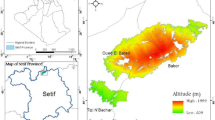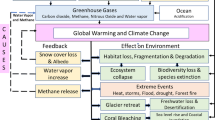Abstract
The lofty and extensive Tibetan Plateau has significant mass elevation effect (MEE). In recent years, a great effort has been made to quantify MEE, with the recognition of intra-mountain basal elevation (MBE) as the main determinant of MEE. In this study, we improved the method of estimating MEE with MODIS and NECP data, by refining temperature laps rate, and dividing MBE plots, and then analyzed the spatio-temporal variation of MEE in the Plateau. The main conclusions include: 1) the highest average annual MEE of the plateau is as high as 11.5488°C in the southwest of the plateau, where exists a high-MEE core and MEE takes on a trend of decreasing from the core to the surrounding areas; 2) in the interior of the plateau, the maximum monthly MEE is 14.1108°C in the highest MBE plot (4934 m) in August; while the minimum monthly MEE appeared primarily in January and February; 3) in the peripheral areas of the plateau, annual mean MEE is relatively low, mostly between 3.0068°C–5.1972°C, where monthly MEE is high in January and December and low in June and July, completely different from the MEE time-series variation in the internal parts of the plateau.
Similar content being viewed by others
References
Barry RG (1992) Mountain Weather and Climate. London and New York: Routledge.
Barry RG (2008) Mountain Weather and Climate. Boulder, USA: University of Colorado.
Fang JY, Ohsawa M, Kira T (1996) Vertical vegetation zones along 30° N latitude in humid East Asia. Plant Ecology 126(2): 135–149.(In Chinese) https://doi.org/10.1007/BF00045600
Fang JY, Guo QH, Liu GH (1999) Distribution patterns of Chinese Beech (Fagus L.) species in relation to topography. Acta Botanica Sinica 41(7): 766–774.
Flenley J (2007) Ultraviolet insolation and the tropical rainforest: Altitudinal variations, Quaternary and recent change, extinctions, and biodiversity. In: Bush M B, Flenley JR, Tropical Rainforest Responses to Climatic Change. Chichester, UK: Praxis. pp 219–235.
Flohn H (1953) High mountains and general circulation. II. Mountains as heat sources, archive for meteorology, Geophysics and Bioclimatology 5A: 265–279. (in German)
Garreaud R (1999) A multiscale analysis of the summer time precipitation over the central Andes. Monthly Weather Review 127: 901–921.
Grubb PJ (1971) Interpretation of Massenerhebung Effect on Tropical Mountains. Nature 229(5279): 44–59. https://doi.org/10.1038/229044a0
Han F, Zhang BP, Tan J, et al. (2010) The effect of mountain base elevation on the altitude of timberline in the southeastern Eurasia: A study on the quantification of mass elevation effect. Acta Geographica Sinica 65(7): 781–788. (In Chinese)
Han F, Zhang BP, Yao YH, et al. (2011) Mass elevation effect and its contribution to the altitude of snowline in the Tibetan Plateau and surrounding areas. Arctic, Antarctic, and Alpine Research 43(2): 207–212. https://doi.org/10.1657/1938-4246-43.2.207
Han F, Yao YH, Dai SB, et al. (2012) Mass elevation effect and its forcing on timberline altitude. Journal of Geographical Sciences 22(4): 609–616. https://doi.org/10.1007/s11442-012-0950-1
Han F, Zhang BP, Tan J, et al. (2014) The effect of mountain basal elevations in Tibetan Plateau and its surrounding areas. Geographical Research 33(1): 23–30. (In Chinese) https://doi.org/10.11821/dlyj201401003
Han F, Zhang BP, Li XC, et al. (2016) MODIS-based estimation of mass elevation effect in the Tibetan Plateau and its ecological effect. Mountain Research 34(6): 788–798. (In Chinese) https://doi.org/10.16089/j.cnki.1008-2786.000187
Holtmeier FK (2003) Mountain timberlines: ecology, patchiness and dynamics. Advances in Global Change Research 14: 369. https://doi.org/10.1007/978-94-015-1254-1_3
Leuschner C (1996) Timberline and alpine vegetation on the tropical and warm-temperate oceanic islands of the world: Elevation, structure and floristics. Vegetatio 123: 193–206. https://doi.org/10.1007/BF00118271
Quervain AD (1904) The uplifting of the atmospheric Isotherms of the Swiss Alps and its relationship with altitudinal limits. Gerland. Contrib. Geophys 6: 481–533. (in German).
SchickhoffU (2005) The upper timberline in the Himalayas, Hindu Kush and Karakorum: a review of geographical and ecological aspects. In: Broll G and Keplin B (ed.), Mountain Ecosystems Studies in Treeline Ecology. Springer, Berlin, Heidelberg. pp 275–354.
Schröter C (1908) The plant life of the Alps: Characterization of the high-mountain flora. Publisher of Albert Raustein, Publisher of Albert Raustein, Zurich, Switzerland. (in German)
Vuille MDR, Hardy C, Braun F, et al. (1998) Atmospheric circulation anomalies associated with 1996/1997 summer precipitation events on Sajama ice cap, Bolivia. Journal of Geophysical Research 103: 11191–11204.
Wang J, Zhang BP, He WH, Yao YH, Zhang WJ, Zhao C (2017) A quantitative study on the mass elevation effect of the Rocky Mountains and its significance for treeline distribution. Physical Geography 38(3): 231–247. https://doi.org/10.1080/02723646.2017.1281013
Yao YH, Zhang BP, Han F (2011) Modis-based air temperature estimation in the Hengduan Mountains and its spatiotemporal analysis. Acta Geograhica Sinica 66(7): 917–927. (In Chinese) https://doi.org/10.1007/s11442-012-0918-1
Yao YH, Zhang BP (2012) MODIS-based air temperature estimation in the southeastern Tibetan Plateau and neighboring areas. Journal of Geographical Sciences 22(1): 152–166. https://doi.org/10.1007/s11442-012-0918-1
Yao YH, Zhang BP (2013a) MODIS-based estimation of air temperature and heating-up effect of the Tibetan Plateau. Acta Geographica Sinica 68(1): 95–107. (In Chinese)
Yao YH, Zhang BP (2013b) MODIS-based estimation of air temperature of the Tibetan Plateau. Journal of Geographical Sciences 23(4):627–640. https://doi.org/10.1007/s11442-013-1033-7
Yao YH, Zhang BP (2014) The mass elevation effect of the Tibetan Plateau and its implications for alpine treelines. International Journal of Climatology. https://doi.org/10.1002/joc.4123
Yao YH, Xu M, Zhang BP (2015a) Implication of the heating effect of the Tibetan Plateau for Mountain altitudinal belts. Acta Geographica Sinica 70 (3): 407–419. (In Chinese) https://doi.org/10.11821/dlxb201503005
Yao YH, Zhang BP (2015b) The spatial pattern of monthly air temperature of the Tibetan Plateau and its implications for the geo-ecology pattern of the Plateau. Geographical Research 34(11): 2084–2094. https://doi.org/10.11821/dlyj201511007
Zhao F, Zhang BP, Pang Y, Yao YH (2014) A study of the contribution of mass elevation effect to the altitudinal distribution of timberline in the northern hemisphere. Journal of Geographical Sciences 24(2): 226–236. (In Chinese) https://doi.org/10.1007/s11442-014-1084-4
Zhao F, Zhang BP, Zhang S, et al. (2015) Contribution of mass elevation effect to the altitudinal distribution of global treelines. Journal of Mountain Sciences 12(2): 289–297. https://doi.org/10.1007/s11629-014-3223-x
Zhang BP, Tan J, Yao YH (2009) Digital integration and patterns of mountain altitudinal belts. China Environmental Science Press, Beijing. (In Chinese)
Zhang BP, Yao YH, et al. (2015) Mass Elevation Effect Research. Beijing: China Environment (Scientific) Press. pp25-26, 182–183. (In Chinese)
Zhang BP, Yao YH (2016) Implications of mass elevation effect for the altitudinal patterns of global ecology. Journal of Geographical Sciences 26(7): 871–877. https://doi.org/10.1007/s11442-016-1303-2
Zhang Q, Qian YF (1999) Monthly mean surface albedo estimated from NCEP/NCAR reanalysis radiation data. Acta Geographica Sinica 54(4): 309–317. (In Chinese)
Zhang S, Yao YH, Pang Y, et al. (2012) Mountain basal elevation extraction in the Taiwan Island. Journal of Geo Information Science 14(5): 562–568. (In Chinese)
Zhang S, Zhang BP, Yao YH, et al. (2013) The effect of Mass Elevation Effect on the distribution of evergreen broad-leaved forests of Taiwan. Journal of Mountain Science 31(5): 534–541. (In Chinese) https://doi.org/10.16089/j.cnki.1008-2786.2013.05.004
Zheng D (2000) Three dimensional differentiation of natural zonation. In: Zheng D et al. (ed.): Mountain Geoecology and Sustainable Development of the Tibetan Plateau. Springer.
Acknowledgements
The research is supported by the Natural Science Foundation of China (Grant Nos. 41401111 and 41601091).
Author information
Authors and Affiliations
Corresponding author
Rights and permissions
About this article
Cite this article
Han, F., Zhang, Bp., Zhao, F. et al. Estimation of mass elevation effect and its annual variation based on MODIS and NECP data in the Tibetan Plateau. J. Mt. Sci. 15, 1510–1519 (2018). https://doi.org/10.1007/s11629-018-4865-x
Received:
Revised:
Accepted:
Published:
Issue Date:
DOI: https://doi.org/10.1007/s11629-018-4865-x




